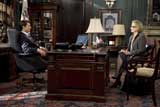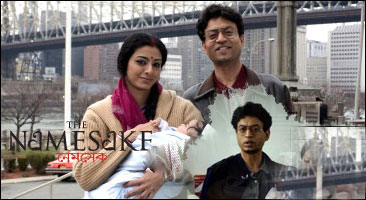Even in a summer blockbuster, sometimes less is more.
Especially when it comes to the story. They throw in so many plots, so many battles, so many tonal shifts, so many characters, and ultimately so many Captain Jack Sparrows that it is clear they are hoping we won’t notice that it really is something of a mess.
It’s a very entertaining mess, though. Like the first two in the series, this ostensible last chapter is filled with visual sumptuousness and splendor, inspired by the classic illustrations of Howard Pyle. Every splintering floorboard, every barnacle, every piece of eight, every skittering crab, every cannon, is brilliantly imaginative. The action sequences are a marvel as well. Though nothing reaches the level of the sensational swordfight on a rolling mill wheel in #2, there are plenty of swashbuckling set-pieces to keep pulses pounding.
That sneery Lord Beckett (Tom Hollander) is after the pirates again, and the only way for Elizabeth Swann (Kiera Knightly) and Will Turner (Orlando Bloom) to stay alive is to get something that Beckett wants very badly from pirate Captain Jack Sparrow (Johnny Depp), who was last seen being consumed by a monster and must now be rescued from an existential crisis in a sort of metaphysical desert at the end of the world.
Lovebirds Will and Elizabeth are each hiding secrets that will test their love and their trust. Sparrow and the formerly dead Captain Barbossa (Geoffrey Rush), brought back to life by Tia Dalma (Naomie Harris), are on hand to help retrieve Sparrow and bring together all of the pirate kings to battle Beckett, now working with squid-faced Davy Jones (Bill Nighy).
Or something like that. It’s very hard to keep track of who is on which side at any given moment, not to mention which ship we’re on or which body of water we’re in at any given moment. Or who knows which secrets or even who is dead, formerly dead, un-dead, or ferrying the dead.
The problem is not the incomprehensibility of the plot; it has been conclusively proven that coherence is not necessary in a summer explosion movie and may even be a distraction. The problem is the tonal shifts; at the same time the movie asks us to care enough about its characters to accept some bittersweet, even tragic outcomes, it throws in some references to suspension of civil rights in wartime (hmmm), and then it also pushes the limits of po-mo ironic self-consciousness with over-the-top in-jokes, silliness about whose, um, telescope is bigger, and a mid-battle wedding ceremony with “I dos” in between ripostes (both literal and metaphoric). This movie’s tongue is pushed so far into its cheek that it could reach Davy Jones’ locker. In the midst of all the visual treats, the movie both takes itself too seriously and not seriously enough. The combination feels sour and overheated, purloining some of the fun that kept the first two so dazzlingly buoyant.
Parents should know that like the other two in the series, this one is filled with non-stop action-style violence, including many fights with swords, guns, hangings, cannons and explosives. Characters are injured and killed, including two who are impaled and some executions. There are macabre and gross-out images. Characters use some salty pirate language and drink rum. There are some mildly ribald comments and some kisses. A strength of the movie is the portrayal of strong female and minority characters. It is also worth noting that this film’s language is slightly less salty than its predecessors and that it is subtly but clearly shown that the main characters wait until they are married to do anything more than kiss.
Families who see this movie should talk about the issues of trust and betrayal. They might also want to talk about how the film-makers made the pirates the good guys by making the people on the other side even worse.
Families who enjoy this movie will also enjoy the earlier episodes, Dead Man’s Chest and The Curse of the Black Pearl
and The Curse of the Black Pearl . They will also enjoy some other pirate movies, including the sly satire The Pirate
. They will also enjoy some other pirate movies, including the sly satire The Pirate , with Judy Garland and Gene Kelly, and the classic swashbucklers The Crimson Pirate
, with Judy Garland and Gene Kelly, and the classic swashbucklers The Crimson Pirate with Burt Lancaster, and Captain Blood
with Burt Lancaster, and Captain Blood with Errol Flynn. Families might also like to see the books and illustrations from Howard Pyle
with Errol Flynn. Families might also like to see the books and illustrations from Howard Pyle , whose paintings inspired the look of these films.
, whose paintings inspired the look of these films.


